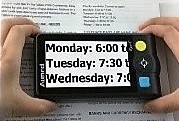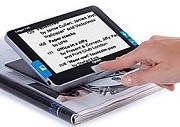Our goal is to provide you with the information you need to learn about available technology and even discover new ways to use technology to enhance your everyday life. We will provide you with training on the latest technologies and devices and you will have the opportunity to use our computer screen magnifiers and screen readers at Beacon House. We can order specialized equipment for you from our preferred suppliers.
When you think of technology from the perspective of people with vision loss, there are two broad categories:
General technology: computers, smartphones and cell phones, GPS devices, etc.
Assistive technology: items designed specifically to help people with vision loss or other disabilities, including everything from screen readers for blind individuals or screen magnifiers for low-vision computer users, to video magnifiers and other devices for reading and writing with low vision, to braille watches and braille printers.
 Smartphones
Smartphones
Smartphones are becoming increasingly helpful as an alternative to a CCTV or a portable digital magnifier. The cameras on smartphones can be used to take a picture of text or an object (a prescription bottle, package, or can, for example) and then enlarge the image for easier reading.
Computers
For people with vision loss, the standard personal computer may be one of the most useful tools available. With surprisingly little effort, you can “surf the net” with the same freedom and speed as any sighted surfer. And since just about every social transaction can be conducted online—from grocery shopping and finding recipes, to banking and paying bills, to earning a college degree, to everyday correspondence—computers can effectively erase many barriers that once limited people with vision loss.
Low Vision Devices
Low vision devices can help you make the most of your vision so that you can perform everyday tasks more easily and with less frustration. Some devices offer very simple and relatively inexpensive solutions, whilst other devices, such as electronic and digital magnifiers, may be slightly more complex and costly. Training to use your devices efficiently and effectively is always one of the main keys to success with the use of low vision devices.
Low vision devices are task-specific, designed for close-up visual tasks or distance viewing. You may require several different devices to accomplish different tasks, depending upon your eye condition and your everyday living needs. These may include stand and hand-held magnifiers, strong magnifying reading glasses, loupes, and small telescopes which are different from regular glasses and magnifiers that you can buy in a local store or online. Most often they require training to help you use them effectively. Other devices can include adaptations such as reading stands, supplemental lighting, absorptive (or glare control) sunglasses, and tactile locator dots.
Flexible-Arm Task Lamps
Proper lighting is critical for good vision. Flexible-arm desk or floor task lamps are perhaps the most helpful and important non-optical devices for many people.
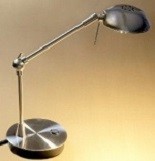
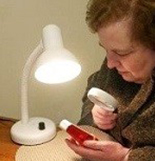
Sunglasses
Glare is a major problem and concern for many persons with low vision. Absorptive sunglasses reduce bothersome glare, enhance or clarify vision in the sunlight, ease eye fatigue, and protect the eyes from injuries, such as walking into low-hanging branches. Sunglasses are not all the same, come by and see our Vision Rehabilitation Professional to understand which sunglasses are best suited for your individual needs.
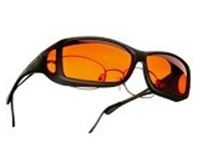
Absorptive sunglasses in amber fit over regular eyeglasses
Typoscopes
A typoscope is a piece of durable black plastic with a cutout opening that can help you focus on the line you are reading. A typoscope can also be used as a signature guide.
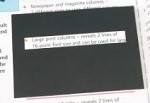
A typoscope in place on the reading page
Locator or Bump Dots
Locator or bump dots are black, red, orange, and yellow raised foam or plastic dots with adhesive backing that are used to mark appliances, dials, computers, and keyboards. They are highly visible and tactile.
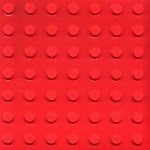
A sheet of orange locator dots
Electronic Magnifying Systems
Electronic magnifying systems come in many different varieties and sizes, depending upon the task or activity you want, or need, to do. Some have a camera system that displays a magnified image on a monitor, which can be helpful for reading mail, books, and magazines, while others are hand-held, portable, and can be taken to the supermarket to read labels and coupons, or to restaurants for reading menus.
Electronic Desktop Magnifiers
An electronic desktop magnifier is equipment that can be helpful for reading, writing, and doing a variety of everyday living tasks. It consists of a camera that is mounted on a frame or arm that displays a magnified image on a monitor. Some models have optical character recognition (OCR) and speech output, in addition to magnifying text or images and showing it on the monitor. This enables the person to hear the text being read aloud at the same time it is displayed on the monitor. This may be very helpful for a person with a serious vision loss. A CCTV can also help with a variety of non-reading tasks such as doing crossword puzzles, doing needlework, or viewing photos.
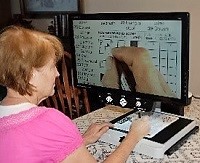
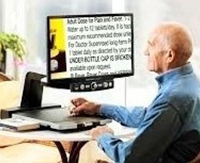
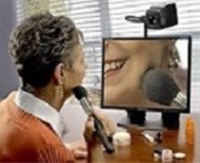
Portable Digital Magnifiers
A portable digital magnifier is a device with a camera on the underside that captures the image of text, pictures, or other items, and a monitor on the top side that displays the image. Monitor sizes can range from 3.5 inches to 13 inches
